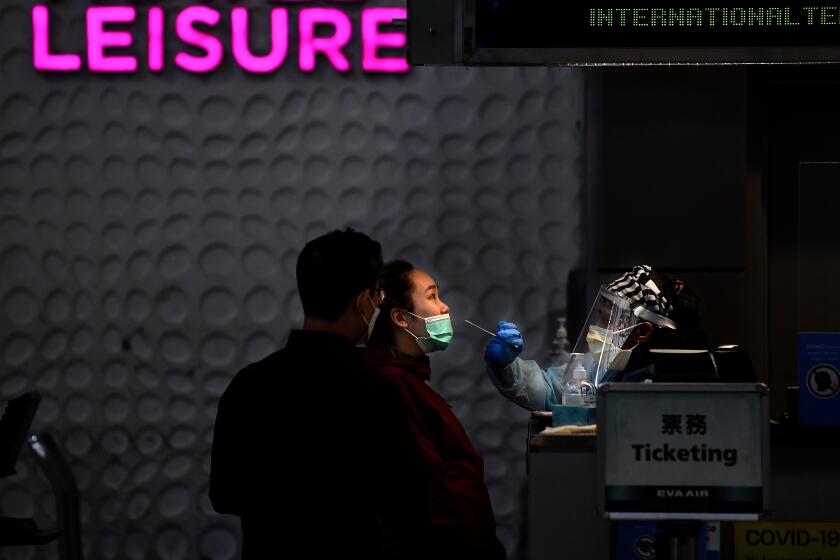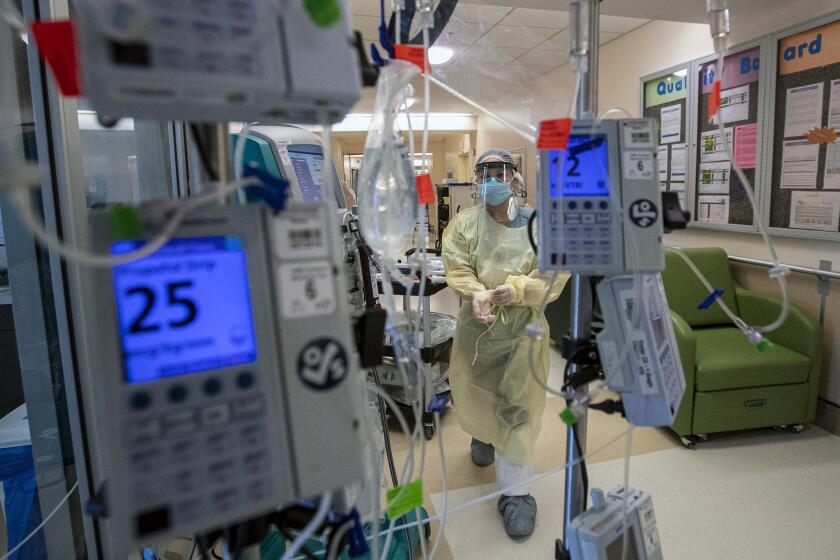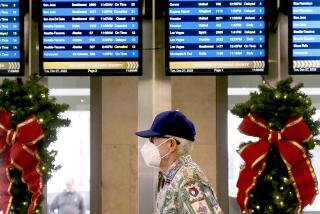From Costco and Target to TV sitcom sets, L.A. workplaces hit with coronavirus outbreaks
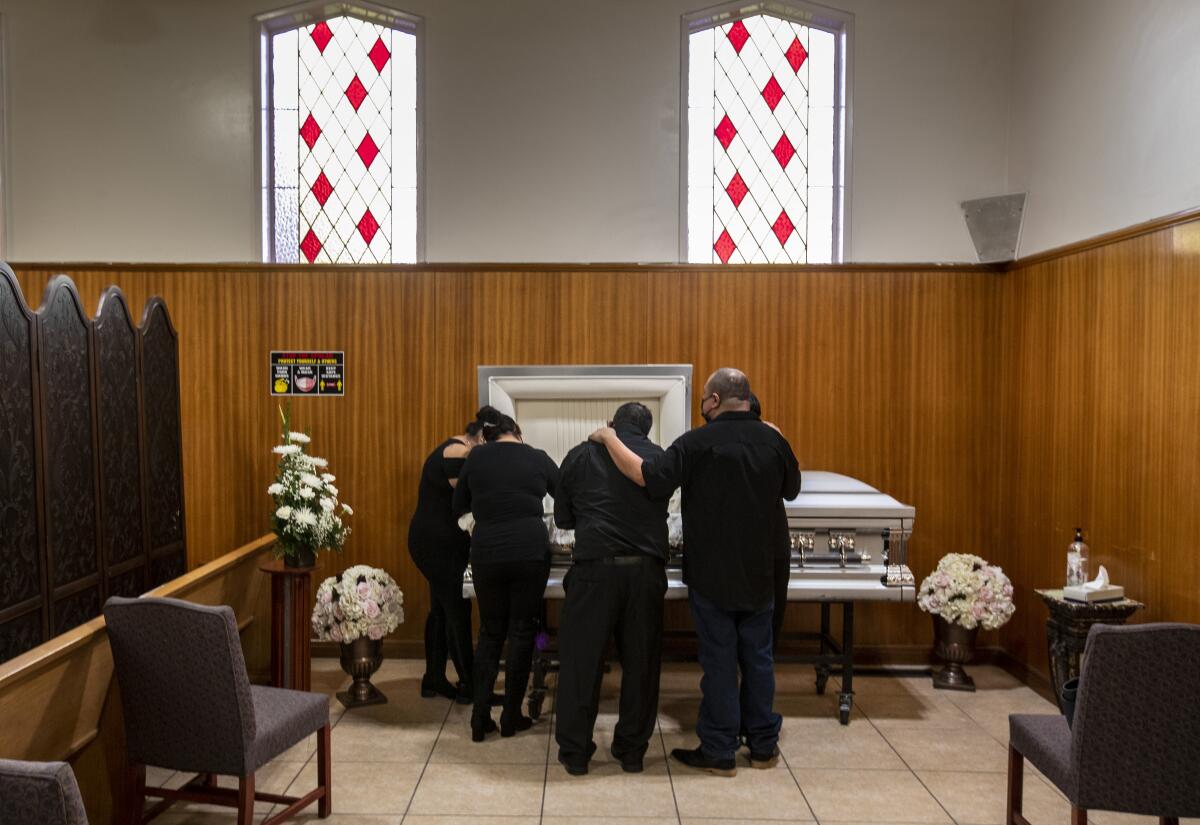
- Share via
With Los Angeles County now a leading hot spot of America’s coronavirus crisis, the statistics are hard to process. A person is dying every 10 minutes. And Mayor Eric Garcetti noted Sunday that a person was getting infected every six seconds.
But one thing about the pandemic has not changed during the darkest phase: those who suffer most. For those with the means to stay home and the ability and determination to avoid gatherings, COVID-19 has remained a relatively low risk. For people living in crowded conditions and who must work, it’s become an even more mortal threat.
Workplaces remain an area of growing concern amid new outbreaks at retail establishments as well as other businesses deemed essential. The massive increase in cases increases the chances of workplace transmission.
“If you had a workplace before where you had 500 workers, there might be one person who was infected, so the risk of transmitting it to a lot of people was lower,” Dr. Jeffrey Gunzenhauser, Los Angeles County’s chief medical officer, said Sunday. “But now, with the prevalence of infection at 1% or higher, if they have 500 employees, maybe five are infected. And it magnifies the chances it can spread in the workplace.”
There are seven Costco warehouses with clusters of confirmed cases of at least 15 infected staffers, with a Culver City location reporting 71 staffers having tested positive for the virus, one in Van Nuys with 50 and another in Woodland Hills with 42. Other affected stores are in Lancaster, Monterey Park, Santa Clarita and the business warehouse in Burbank, according to data released by the L.A. County Department of Public Health.
The California Department of Public Health on Nov. 13 issued an advisory urging Californians to stay home or in their region and avoid nonessential travel, including for tourism or recreation.
There are eight Home Depots in L.A. County with active outbreaks, including in Alhambra, Cypress Park, Downey, South L.A., North Hollywood, Panorama City, Van Nuys and Signal Hill, near Long Beach. Ten outbreaks at Target locations in L.A. County have been reported recently, with 217 staff members infected.
There also have been infections recently among staff at six McDonald’s locations, four Chick-Fil-A restaurants and two In-N-Outs; at Best Buy stores in Downey and West Hollywood; the Nordstrom in Cerritos; Trader Joe’s in Glendale and North Hollywood; Whole Foods markets in Santa Monica and Sherman Oaks; and Apple stores at the Beverly Center, Glendale Galleria and Los Cerritos Center. Apple closed retail locations in California before Christmas because of the surge.
New outbreaks have been reported at Los Angeles Fire Department stations. There are at least nine ongoing outbreaks at stations that have infected at least 65 people.
There are also three ongoing outbreaks among people who work at Los Angeles International Airport, including at American Airlines and JetBlue Airlines. At least five people who work for LAX police have also contracted the coronavirus recently.
The virus is also hitting the entertainment industry, which stay-at-home rules have deemed an essential business. There have been clusters of coronavirus infections identified recently among workers at three Warner Bros. productions in Burbank — “Lucifer,” “The Kominsky Method” and “Young Sheldon.” In total, 35 people have tested positive as part of those infections.
One of the largest hospitals in San Bernardino County ran out of ICU space two weeks ago amid an onslaught of coronavirus cases across Southern California.
An additional 45 coronavirus cases have been identified at the CBS Studio Center in Studio City, according to the county data. Twenty-three cases have been identified among workers at NBC Universal in Studio City and Universal City, including on the production of the show “Mr. Mayor.” There have been nine coronavirus cases among staff at Netflix Productions’ office in Gardena.
L.A. County public health officials have urged filmmakers to consider pausing work for a few weeks during what they called a “catastrophic surge in COVID cases.”
CBS Studios, Universal Television, ABC Signature, 20th Television, Warner Bros. Television and Sony Pictures Television have delayed production on a number of TV shows.
By Sunday night, an agreement had been reached by actors union SAG-AFTRA and groups representing film and TV producers and advertisers to recommend a temporary hold on in-person production in Southern California, according to the union.
“Southern California hospitals are facing a crisis the likes of which we have never seen before. Patients are dying in ambulances waiting for treatment because hospital emergency rooms are overwhelmed. This is not a safe environment for in-person production right now,” SAG-AFTRA President Gabrielle Carteris said in a statement.
The outbreaks can sometimes represent poor infection control practices at businesses, but sometimes they don’t. Earlier in the pandemic, officials said some outbreaks — defined as three or more reports of infections among workers at a business over a 14-day period — are more a sign of how widespread the virus is in this county of more than 10 million people, where the virus can be passed from social gatherings to workplaces and then to new homes — a vicious cycle.
A woman who worked at a San Jose hospital has died of COVID-19 in an outbreak possibly tied to a colleague who wore an inflatable holiday costume.
There is no doubt that a major factor in virus transmission is social gatherings, including holiday family events and big New Year’s Eve parties. LAPD and Sheriff’s Department officials said they broke up at least 13 New Year’s Eve gatherings involving more than 2,900 people and arrested at least 90 adults on suspicion of violating the stay-at-home order.
One thing is also clear: Coronavirus risk varies by community. Latino residents are now dying of COVID-19 at 2½ times the rate of white residents in L.A. County, a disparity that has widened since the pandemic has worsened in California’s most populous county. Compared with white residents, Black residents are twice as likely, and Latinos three times as likely, to be hospitalized for COVID-19.
It’s also becoming increasingly likely that the virus is spreading more often at workplaces run by essential workers, who then transmit the virus to family or roommates at home.
That is particularly a concern in Los Angeles County’s densely populated, heavily Latino neighborhoods, which have some of the worst rates of virus cases.
“I think it makes sense now, with the surge, that there are actually multiple pathways for people who are highly vulnerable to get infected,” Gunzenhauser said. “Between where they live and where they work, the risks are just greater for these individuals.”
The disproportionate toll suffered by communities of color has been a problem since the beginning of the pandemic. But after the second surge of the pandemic faded in the late summer and early autumn, the disparity among Latino and Black communities compared with white residents declined. The new surge has made the inequities worse.
“The progress we’ve made over the summer has completely evaporated,” L.A. County Public Health Director Barbara Ferrer said. “The gaps again have dramatically widened, particularly for Latinx residents compared to other groups, although all groups are experiencing increases in cases, hospitalizations and deaths.”
Coronavirus case and death rates are also growing far more rapidly for people living in impoverished L.A. County neighborhoods than they are for people living in the wealthiest areas. Among the communities with the county’s highest coronavirus case rates: South L.A., the eastern San Fernando Valley, Boyle Heights, East L.A., and Southeast L.A. County.
Experts say people who must leave home to work and those who live in crowded housing arrangements, often due to the high cost of housing, are at higher risk of contracting the coronavirus.
“We’re the densest metro area in the United States. But we’re also seeing the household spread now,” Garcetti told the CBS News program “Face the Nation” on Sunday. “One person is coming home — an essential worker — there might be five, seven, 10 people in that household. And this is a worrying trend that the fatalities now are not just people with preexisting conditions.”
Earlier in the pandemic, only a small fraction — 7% — of people dying of COVID-19 had no underlying medical conditions. Now, 14% of the deaths in L.A. County have been among people with no underlying medical conditions, according to data provided by Ferrer.
“There are more people than ever not only passing away, but passing away without any underlying health conditions,” she said.
Gunzenhauser said that the holiday season had been brutal and that L.A. County should expect daily coronavirus case numbers to rise well into January, which will add even more pressure at hospitals in crisis.
“The holidays have been a major challenge,” he said, “because the human need to be with family and friends to celebrate these times is so strong.”
Here is a more detailed look at coronavirus rates by race and ethnicity.
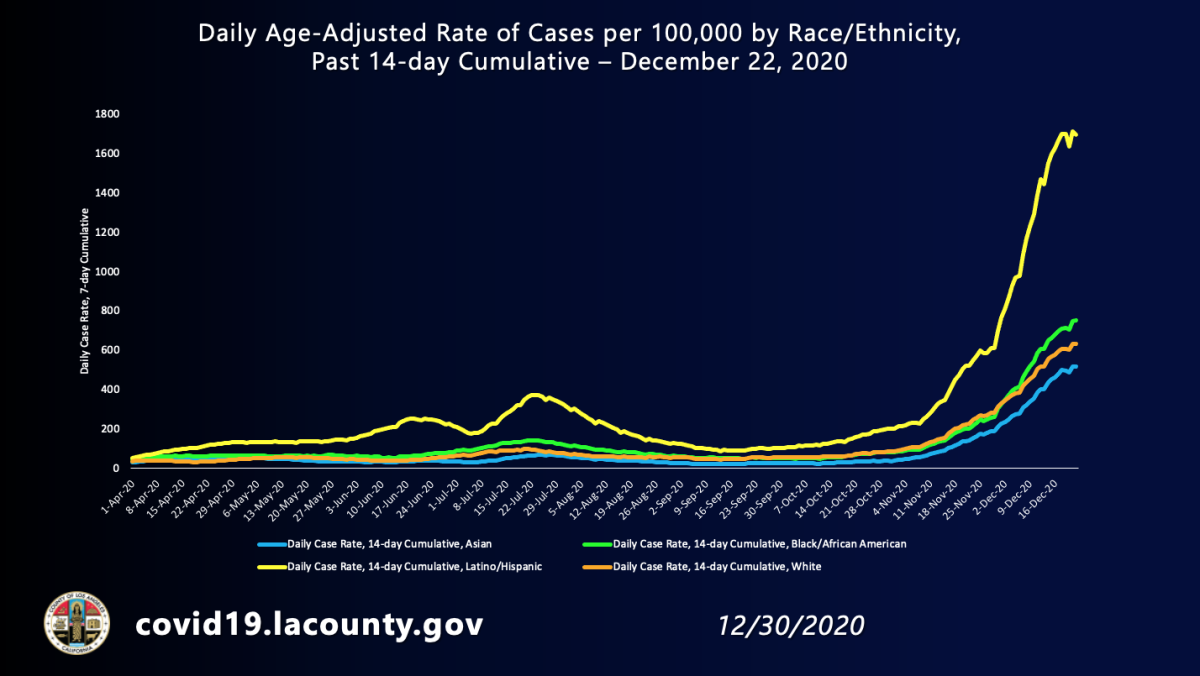
Coronavirus daily case rate by race and ethnicity:
Latino: 1,696 coronavirus cases per 100,000 Latino residents
Black: 752 coronavirus cases per 100,000 Black residents
White: 636 coronavirus cases per 100,000 white residents
Asian American: 519 coronavirus cases per 100,000 Asian American residents

COVID-19 weekly rate of hospitalizations:
Latino: 80 hospitalizations per 100,000 Latino residents
Black: 58 hospitalizations per 100,000 Black residents
White: 26 hospitalizations per 100,000 white residents
Asian American: 26 hospitalizations per 100,000 Asian American residents

COVID-19 daily rate of deaths:
Latino: 16 deaths a day per 100,000 Latino residents
Black: 8 deaths a day per 100,000 Black residents
Asian American: 8 deaths a day per 100,000 Asian American residents
White: 6 deaths a day per 100,000 white residents
Times staff writers Thomas Suh Lauder, Luke Money, Maloy Moore and Kevin Rector contributed to this report.
More to Read
Sign up for Essential California
The most important California stories and recommendations in your inbox every morning.
You may occasionally receive promotional content from the Los Angeles Times.
